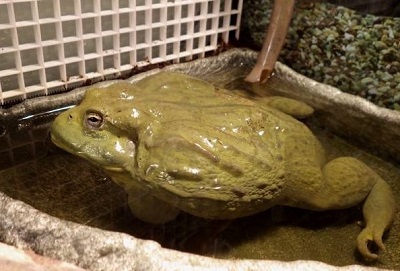
If you were following us on Twitter @ExoticPetVets and humming “Joy To The World” by Three Dog Night this month, we wouldn’t be surprised. But now that November is winding down, it’s time for us to bid a fond farewell to the African bullfrog as our Animal of the Month. And if you were distracted by singing the words “Jeremiah was a bullfrog. Was a good friend of mine…” and missed some of our tweets, we have a summary for you. Did you know?:
- The African bullfrog (Pyxicephalus adspersus) is a large frog that – as the name suggests – is found across a large swath of southern and parts of central Africa, from South Africa to Kenya.
- African bullfrogs are also known as pixie (or pyxie) frogs. It’s derived from their scientific name, but it can mislead those unfamiliar with the frogs’ taxonomy. In folklore, pixies are small creatures. But African bullfrogs are among the world’s biggest frogs.
- We often associate frogs with living in or near water. But in the wild, African bullfrogs live in harsh semi-arid and arid environments such as savannas.
- Because of their unusual habitat in the wild, African bullfrogs have an unusual life. During the dry season, they will burrow deep into the ground and stay there in aestivation, which is a type of dormancy similar to hibernation.
- When African bullfrogs are in aestivation underground, they will develop a watertight cocoon of dead skin layers in order to help keep them moist.
- African bullfrogs will stay underground in aestivation for many months as they ride out the searing heat of the dry season. While they are in this state, their metabolism and breathing slow way down in order to preserve energy.
- When the rainy season arrives, African bullfrogs will emerge from their burrows to mate. Because the rainy season is much shorter than the dry season, African bullfrogs end up spending most of their lives underground.
- November 13th was a Friday and frogs – including African bullfrogs – are the subject of many beliefs and myths. They are also prominent characters in popular culture and fairy tales.
- According to the web site Learn Religions, the Xhosa people in southern Africa discourage killing frogs who make their way into your home because the frogs could be bringing you a curse or a blessing.
- Some African tribes also believe that killing a frog will bring drought to the area, also according to the web site Learn Religions.
- African bullfrogs are huge frogs, with male adults measuring between 8-10 inches (20-25 cms) and weighing between 2-3 lbs. (about 1-1.3 kgs).
- Female African bullfrogs are about half the size of their male counterparts, which is unusual because females are typically larger than males in most frog species.
- African bullfrogs have plump bodies and are mostly olive green, with lighter coloured throats that are cream or white in females and orange or yellow in males.
- Both male and female African bullfrogs have long raised skin ridges on their backs and the backs of their heads.
- African bullfrogs will emerge from their burrows underground during the rainy season to mate in what could be described as a “Fight Club” of sorts.
- A large group of male African bullfrogs will gather in shallow water, with the larger males in the middle and the younger, smaller males on the periphery.
- The larger African bullfrogs will try to prevent their younger counterparts from breeding, most often by fighting with them and causing injury or even death.
- For her part, a female African bullfrog will swim underneath the melee and surface in the middle of the group in order to mate with the dominant male.
- A female African bullfrog will lay between 3,000 and 4,000 eggs at a time and they will all hatch in just two days.
- The male African bullfrog is a protective father – sometimes. He will watch over his tadpoles and will aggressively defend them against any perceived threats. But there may also be times when he will eat some of his own tadpoles.
- Another way male African bullfrogs protect their young is to ensure they have enough water in the shallow temporary pools of water in which they are developing.
- If a pool of water is in danger of drying out, the male African bullfrog will use his hind legs to dig a channel that connects to another water source so his tadpoles can survive.
- No one could ever accuse African bullfrogs of being picky eaters. They will eat anything that will fit into their large mouths; including – but not limited to – other frogs, insects, small mammals reptiles and birds.
- African bullfrogs are ambush hunters. When prey crosses their paths, they will forcefully drop their lower jaws. Their tongues, which are folded over inside their mouths, will lash out and capture the prey.
- African bullfrogs also have three tooth-like structures on their lower jaws called odontodes, which help them restrain any prey animals or insects who may be putting up a fight.
- African bullfrogs have a long lifespan. While their lifespan is typically about 20 years, they can live beyond the age of 40.

